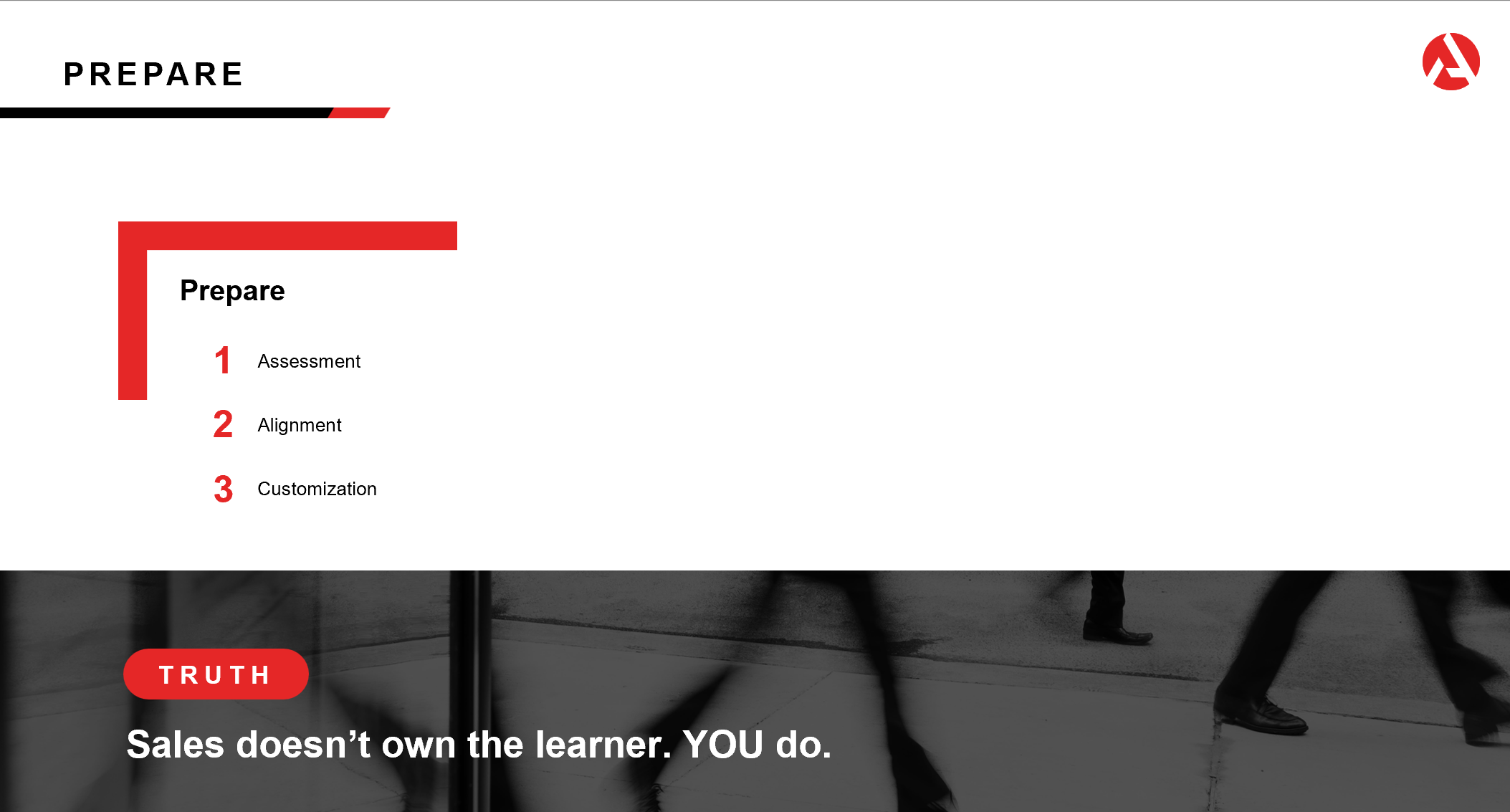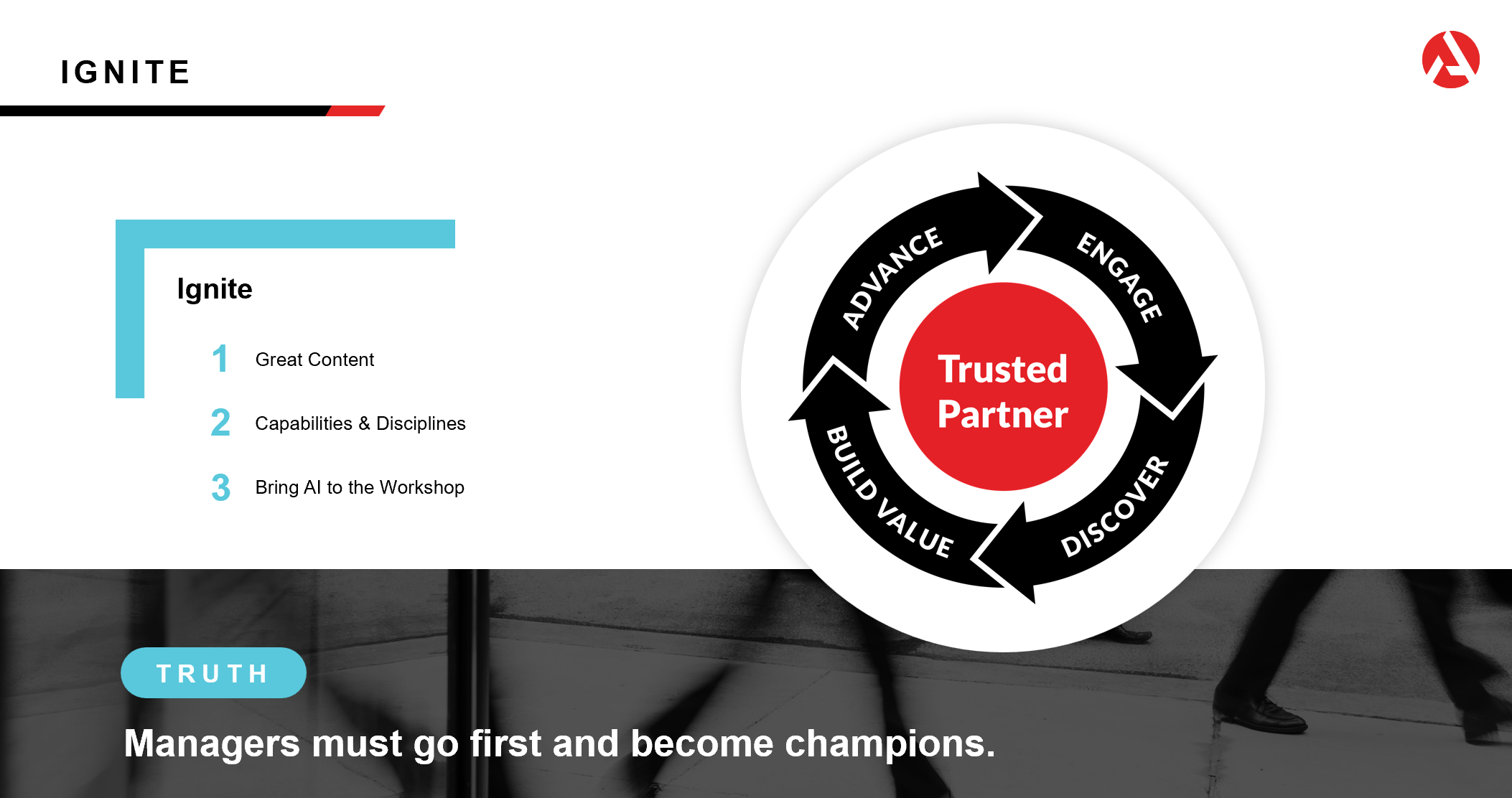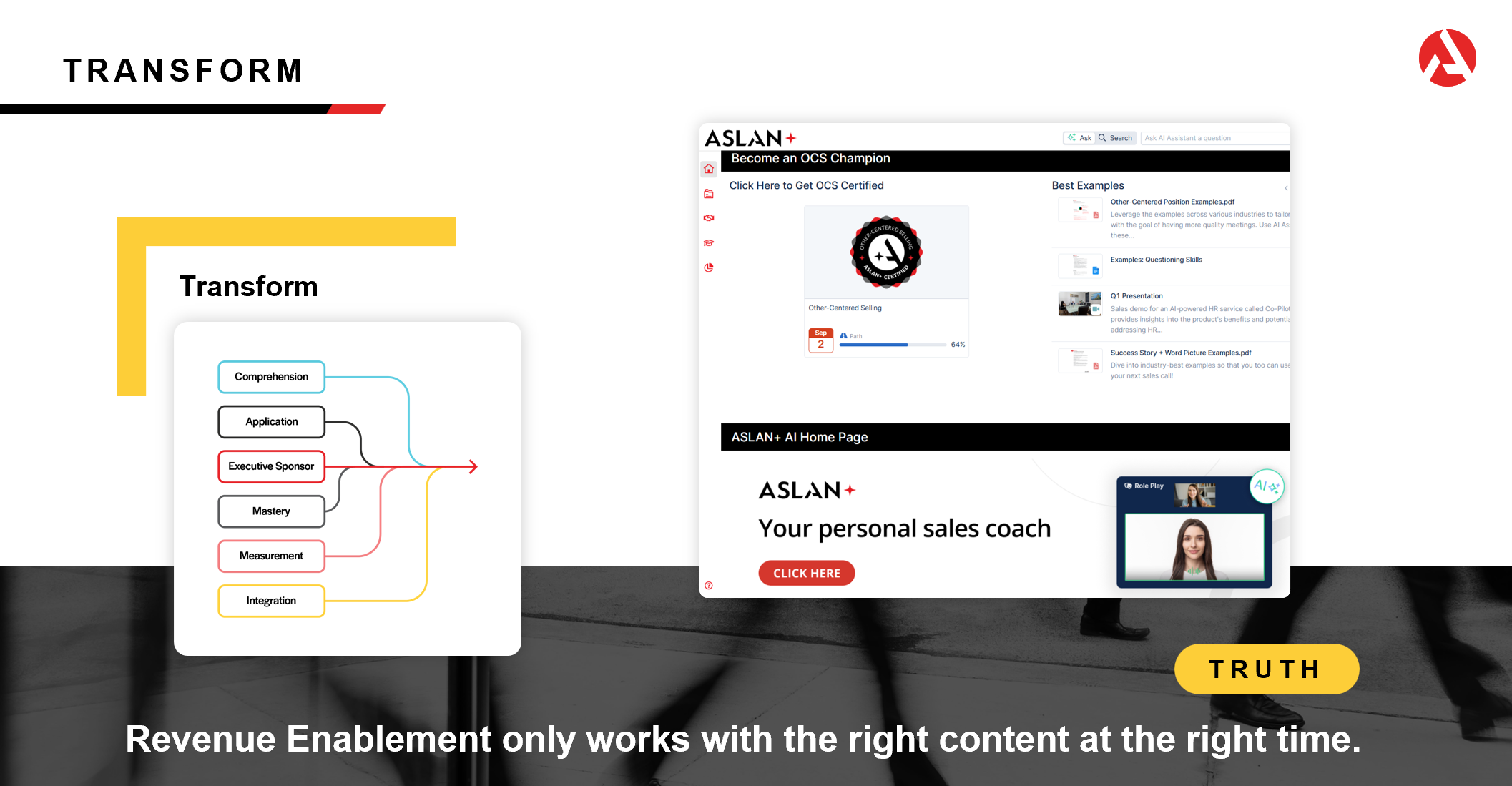From Content to Capability: Leveraging AI to Accelerate Training Adoption
By ASLAN Training
November 6, 2025
9 min read
Only a day after training, your team will have forgotten half of what you taught them. By the end of the week, they'll have forgotten 90% of it. Not because your content is weak, but because your brain is built to forget.
That's the Forgetting Curve.
This reality sits at the heart of a larger problem in sales training: we're solving for the wrong metric. We measure whether people remember the material. But memory isn't the goal. Transformation is.
At ATD Sell 2025, our VP of Training Jesse Rome addressed this tension directly.
The gap between what training leaders are asked to deliver and what actually drives sustainable capability has never been wider. Add AI to the mix, and the pressure compounds. Yet AI, if positioned correctly, can accelerate a framework that works.
Watch the full presentation below:
Why Take an Other-Centered® Approach to Sales Enablement & Training
Most training is built to check boxes, not change behavior.
Because sales enablement leaders are under pressure to prove value, programs get optimized for executive approval: well-designed content, clean decks, quiz scores, and attendance rates. That’s what’s visible. That’s what’s safe. But is it what your sales teams actually need?
To drive real capability, you have to flip the pyramid. Put the sales team at the top, not the bottom.
That’s the Other-Centered® approach: start with the people who have to use the training, not the people who sign off on it. Until you earn buy-in at that level, nothing sticks.
This misalignment shows up most clearly in the metrics:
-
Knowledge: Did they learn it? (Quiz results, comprehension checks)
-
Adoption: Did they use it? (Observable behavior on calls, in real scenarios)
-
Transformation: Did it change results? (Win rates up, deal velocity faster, forecast accuracy better)
Most programs measure knowledge, declare success, and move on. But the organization is waiting for adoption. Leaders are waiting for transformation. And the people who actually need the training? They’re stuck with something that wasn’t built for them.
So what does it take to drive adoption that sticks? It starts with earning the right to be heard. From there, the most effective programs follow a three-stage framework: Prepare, Ignite, and Transform.
Below, we'll explore how it all works.
Start With Receptivity, Not Content
Before you build content, ask this: Have you earned the right to be heard?
And be clear on who needs to hear it. Your audience isn’t your executive sponsor; it’s the sellers, managers, and peer influencers who will decide whether this training takes root. If they’re not receptive, even the best-designed initiative will stall.
What you need to understand first:
- What pressures are they facing right now?
- Why should they care about this training?
What objections will they bring? - Whose voices do they actually trust?
Receptivity work is uncomfortable. You might hear that your idea isn't compelling. But this front-end work separates training that sticks from training that fades.
Use The Three-Stage Framework to Drive Transformation
Adoption doesn’t happen on its own. Even when the content is strong. You need a structure that drives momentum from day one and sustains it over time.
Think of this as the stop, drop, and roll of training execution. Whether you have weeks or months, this three-stage framework (Prepare, Ignite, Transform) helps you drive lasting behavior change.
1. Prepare: Investment Up Front

The Prepare stage is where you build the foundation: diagnose performance challenges, get buy-in from both leaders and influencers, and customize content so people can see themselves in it. When you invest here, everything else works better.
Here’s what that looks like in practice:
- Start with assessment. Before you deliver training, you need to understand what's on your sales teams' and managers' whiteboards. Ask people what they need; don't assume. You can use your learnings to build training that aligns more closely with learners' needs.
- Secure alignment. You need visible leadership championing the work: when the CRO speaks, people listen. But you also need emerging leaders and SMEs. These are the people teams actually trust, and they can offer insights into the team's needs and feelings that you might not access on your own.
- Commit to customization. Use imagery from their industry. Reference their customer dynamics. When people see themselves in the content, receptivity rises.
Here's the disruptive truth underpinning everything: You own the learning experience. Sales doesn't. So, for example, when a sales leader demands a two-week turnaround with immediate ROI, be clear about the trade-off. For example: "Medium impact in two weeks, or high impact in four weeks with proper reinforcement. It's your choice."
When this preparation is skipped, the entire initiative struggles to land, no matter how good the content is. With it, you build the foundation for real engagement.
2. Ignite: Design Great Content to Encourage Adoption

Your preparation will tell you what matters to your audience. But the content itself will determine whether your training actually lands with them.
Great content should be well-organized, and have good instructional design. Use this framework:
- Embrace: Establish why this matters before you teach anything. Connect it to profit or purpose: something they actually care about. If you can't make that case clearly, you haven't earned the right to proceed.
- Experience: Ground the content in real scenarios with real objections and real customer conversations. Not theory. Not hypotheticals. Show them how this works in their world, in their language.
- Execute: Make them practice. In the workshop, in breakout groups, through AI roleplay, and with coaching afterward. If they don't practice it before they leave the room, they won't use it when they're back on the phone.
Elevate your content even further by ensuring that you have a shared language or methodology across each role, location, or business unit. This makes it easier to coach, build and scale trainings that resonate.
Pro tip: As AI-enabled tools continue to develop, build them into your workshops directly, instead of using them as an post-workshop add-on. This not only sparks interest, but also creates a valuable opportunity to familiarize your team with the AI tools you want them to use.
Where Most Training Falls Apart: Managers Don't Go First
Managers are the single biggest multiplier in any training initiative. Yet most programs treat manager enablement as an afterthought, assuming managers will figure it out on their own. They won't.
Why do managers fail to champion training?
- They don't prioritize it because it's not clearly tied to profit or purpose
- They don't know how to coach (most conflate demonstration or feedback with coaching)
- They don't actually know how to sell in today's environment (promoted 20 years ago when the game was different)
If you want adoption, you have to solve for manager mastery first.
3. Transform: Sustain Change Over Time

Transformation doesn’t happen in a workshop. It happens when five elements work together to sustain behavior change after the training ends:
- Comprehension: First, you need to establish that people remember and understand the content. Simple quizzes and knowledge checks confirm that reps absorbed the material. It's table stakes. But it’s also just the beginning.
- Application: In other words, does the team actually practice what they learned in training, in real-life scenarios?
- Mastery: If the managers are not masters of your training and content, everything else is likely to fail. Why? Because what they demonstrate becomes the team’s standard. If they’re not visibly using the framework, the rest of the team won’t either.
- Measurement: In other words, does it connect to revenue? You can’t just track attendance or completion rates. To earn leadership buy-in, tie enablement to the metrics that matter: win rates, pipeline velocity, forecast accuracy. When you do that, you’re not just reporting training outcomes; you’re making the case for revenue enablement.
- Integration: That’s what revenue enablement really means: building capability inside the rep’s daily flow of work. Not another tool to log into. Not another checklist to complete.
It’s surfacing coaching prompts in the CRM. It’s delivering content in context, when and where it’s needed. Integration is how enablement shifts from being a support function to a performance driver.
When these five are in place, change sticks, and capability becomes part of how the team operates.
AI is an Accelerator, Not a Solution
AI is a powerful amplifier, but it won’t fix what’s broken. It can accelerate momentum and simplify execution, but only when the foundation (your content and strategy) is strong.
To make the most of AI tools, think of them as as a way to scale what’s already working, not a substitute. If your team isn't aligned, or if the content doesn’t resonate, no AI tool will compensate.
Where it helps:
-
Diagnose capability gaps using performance data
-
Generate coaching prompts and discussion guides
-
Simulate real scenarios through roleplay and practice
-
Reinforce content through embedded, in-the-moment access
But remember: it’s not the tool; it’s how your team uses it. Adoption depends on the people behind the platform, not the platform itself.
Want to Achieve Transformation? Capability is the Metric to Target
If you want real transformation, start tracking the right thing.
Capability, not content, is the benchmark for success. It's what sellers need to drive results. It's what leaders expect from training. And it’s what earns enablement a seat at the table.
Here's what that requires:
- Managers modeling the change.
- Training embedded into real workflows.
- Reps receptive before the first slide.
- Metrics that tie directly to revenue outcomes.
When you deliver capability, you stop being seen as a cost center—and start being seen as a competitive advantage.
Want to see what capability-building actually looks like in practice?
Learn more about ASLAN+ and how it helps training teams drive lasting adoption, without adding more to your plate.
Unlock Your Team's Full Sales Potential
Questions? Watch our CEO, Tom Stanfill, address our frequently asked questions below.

